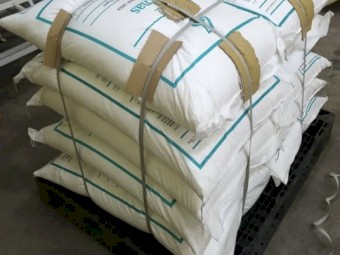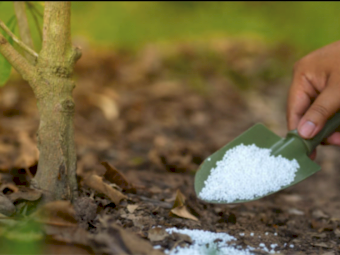$685.00 + GST ($753.50 Inc. GST)

Details
| Status | : | Farm Inputs |
| Location | : | Elmore, Northern Country, VIC |
| Category | : | Fertiliser, Urea |
| Listing Date | : | 31/05/2023, 02:40pm |
Description
within the plant is redirected to developing grains. Carbohydrates are then deposited within the grain, and it is the level of carbohydrates that determine grain size and yield. This dilution of nitrogen in grain also determines final grain protein levels.
In short dry springs, crop yields are reduced because they are unable to fill each grain, and the percentage of grain protein is much higher and often grain size is smaller. Longer soft finishes to the growing season, result in crops filling grain to their full capacity. With this scenario where adequate nitrogen is not available to maintain a higher yield and protein the dilution of nitrogen levels in the grain may result in low grain protein levels.
The idea of using grain protein concentration to assess the likelihood of N responsiveness wheat in cropping systems in South Australia was described 50 years ago (Russell, 1963). The work suggested yield responses were most likely when grain protein concentration was <11.4% (McDonald & Hooper, 2013). This is supported in trial results from the IPF Long Term Trail at Glenelg in Central NSW (Figure 3), where yield response to nitrogen plateaus in the 11-12% protein range and protein % continues to increase with additional nitrogen.
In winter cereals it can be a juggling act to manage additional nitrogen inputs between pre-plant and booting and, in irrigated and high rainfall systems, though to flowering in order to achieve the targeted yield, grain size and protein results.
Throughout this process it is critical that nitrogen is identified as the only limitation. As Table 1 shows there are many other thingsthat will affect crop yield and protein potential.
NITROGEN BUDGETING
The first step in planning nitrogen applications is a simple budgeting process to assess nitrogen demand – the nitrogenrequired to grow a target yield and protein. Once you know the N demand, you can determine the amount of fertiliser/nitrogen required.
Estimating existing nitrogen supply: There are several tools available to advisers to help determine the existing nitrogen supply, such as reviewing paddock fertiliser and crop histories, deep soil nitrogen test, in-crop NDVI, shoot density. The best decisions are made using credible information collected from a range of sources.
Paddock history:
Information such as previous crop yield, previous grain protein levels, crop rotation, fallow weed control, soil moisture levels,
seasonal conditions and expectations can all help guide topdressing decisions. For example, where paddocks produced wheat crops in 2021
with less than 10.5 to 11%, it suggests nitrogen supply was limiting. There may be higher soil nitrogen levels in 2022 in those paddocks in the rotation coming off a legume pasture or pulse crop phase in 2021.
Relying solely on paddock history information can be misleading at times, as no direct measurements are taken. The guiding ‘4R’ principles of the right source, rate, time, and place of fertiliser requires knowledge of both crop demand and soil N supply.
Seasonal conditions remain the primary driver of crop demand for N in dryland cropping systems and to a significant extent also fertiliser use efficiency.
Deep soil nitrogen tests:
Pre-plant deep soil nitrogen test results are an excellent resource for nitrogen management. One of the disadvantages in low soil nitrogen paddocks if additional nitrogen has not been applied at seeding is there may be a requirement for early topdressed nitrogen at mid-tillering to establish the desired target shoot density by GS30. Monitor the paddocks that you know (either by deep N soil test results or paddock history) to have low soil nitrogen levels. Don’t always wait until GS30 to assess crop performance, early nitrogen may be required to achieve the desired target shot density by GS30. The application of 15 to 30 kg N/ha may be required to stimulate additional tillers. Easy N® through streamers or dribble bars is ideally suited to this scenario with accurate placement, timely application and potentially lessvolatilisation losses than urea on alkaline soils. Sampling in-crop can also play a role where deep N test weren’t taken pre-plant. When sampling post planting, be careful to avoid
any banded pre-plant nitrogen or starter nitrogen fertilisers. In-crop deep nitrogen test results should be used in conjunction with the percentage of total nitrogen in above ground dry matter, especially where dry matter is above 1000 kg/ha, to calculate the total available nitrogen.
TIMING CONSIDERATIONS
Nitrogen applications before GS30 can increase tiller numbers and dry matter, leading to yield increases. The greatest demand for N is when the leaf area is expanding rapidly, and the crop is growing most rapidly. Nitrogen applications between GS31 – GS37 correspond to the period of stem elongation and at this time peak growth rates can be of the order of 200 kg/ha/day and crops can be accumulating N at 2-3 kg N/ha/day (McDonald, 2013). Some carry-over of nitrogen into grain protein may occur. When nitrogen is applied after GS59, it is generally to manipulate
grain protein and maintain yields in above average seasons. Nitrogen use efficiency is reduced at these later stages of application. Conditions and likely returns need to be assessed carefully.
Remember that it is only when the yield potential has been reached that additional nitrogen can contribute to higher grain
protein levels.
MAXIMISING NITROGEN USE EFFICIENCY
To maximise nitrogen use efficiency, apply N when the crop will respond:
prior to periods of rapid growth
when the soil moisture profile is full and the season outlook is favourable.
to paddocks free from soil limitations such as compaction, sodicity, acidity, salinity.
where root diseases (such as crown rot, rhizoctonia and take all) are non-limiting.
when leaf disease (such as strip rust, yellow leaf spot, Septoria) are non-limiting
where weeds and insects are controlled
where losses of nitrogen through volatilisation may occur, consider Green Urea NV®
NITROGEN LOSSES WHEN TOP DRESSING
When broadcast on the soil surface both liquid or dry urea or urea containing products or blends can be susceptible to ammonia (NH3) loss. The ratio of ammonia to ammonium determines the potential for ammonia loss. The higher the initial soil pH and the pH in the reaction zone, the greater the potential for volatilisation of the ammonia. Losses from alkaline soils in south-east Australia have been measured as high as 23% of total N lost through volatilisation over a period of 20 days on an alkaline clay applied in the first week of September (Turner et al, 2012).
Factors favouring NH3 volatilisation losses from top dressed urea are:
light rain post application, enough to dissolve the urea granule but not enough to wash the dissolved granule into the soil
crop residue on the soil surface
temperatures above 18°C
alkaline soils
wind
low soil cation exchange capacity
application to a moist soil that dries after application
The safest applications are those made to dry clay soils, in low humidity conditions with no wind and sufficient rainfall to move the urea into the soil within a few days of the application. The cost of N losses on highly N responsive situations will be more than just the value of N. If grain yield is compromised, which is highly possible on low N soils, the outcome will be worse. Where starting soil-N is low, the yield response from applied N fertiliser could be as much as 20 kg grain per kg N. If 9 kg/ha N is lost from an application of 100 kg/ha N, the resulting yield reduction maybe 180 kg/ha or $90/ha. Combine this with the value of the lost N ($33/ha), the reduction in income maybe $123/ha. This makes an investment in products that can reduce volatilisation an excellent return on investment. Note: assuming urea @ $1700 per tonne, wheat @ $500 per tonne.
Green Urea NV is a urea-based product that is treated with N-(n-Butyl)-thiophosphoric triamide (NBPT). When NBPT is added to urea it inhibits the activity of the urease enzyme for a period of up to 14 days. During that period the losses of N as NH3 from the surface applied urea are significantly reduced and N is still present for the next rainfall event.
Green Urea NV gave a statistically significant yield response compared with the control and urea. Green Urea NV also gave a significant protein increase compared with the control and urea. Wheat productivity and nitrogen use efficiency was measured at another three sites in the Wimmera region of Victoria, Australia between 2012 and 2014. At those sites NBPT (the urease inhibitor in Green Urea NV increased yield (+ 7–11%) in 2 of 3 years compared to unamended urea (Wallace et al, 2019). Incitec Pivot Fertilisers trial work in the Mallee in 2014 also
demonstrated the effectiveness of Green Urea NV over urea with an early September top-dress and 17 days before a welcome rainfall event of 35mm. The Green Urea NV treatment returned a significant grain yield response over urea (0.41t/ha), protein response (0.7%) and improved nitrogen use efficiency from 33.7% for urea to 60.5% for Green Urea NV. In another field study the N management strategy significantly affected losses of fertiliser N depending on seasonal conditions, with urease inhibitors (NBPT) producing significant benefits in reducing losses of top-dressed urea under dry seasonal conditions (Armstrong et al, 2021). When top dressing large acreages, top dressing can commence four to six days before a significant rainfall event with confidence that all the nitrogen is still available for incorporation into the soil profile when that rain front comes through. All farming systems should aim to maximise nutrient use efficiency. When choosing the most appropriate product to apply consideration should be given to the rate of application, the frequency of application, the timing of the application, the economic objectives, and any environmental consequences.




















Share Listing Via